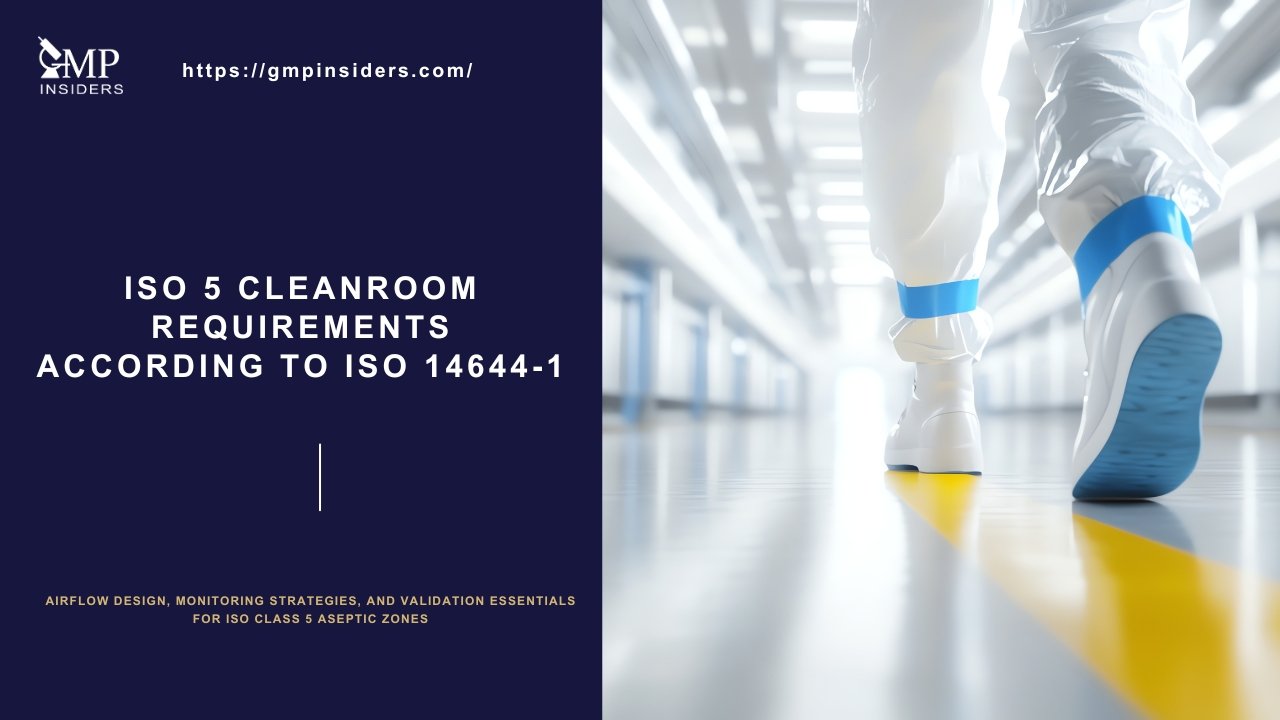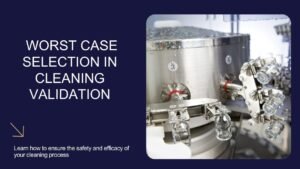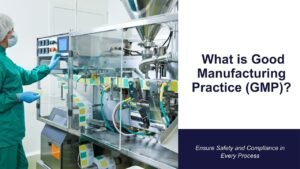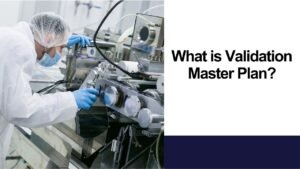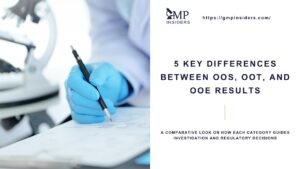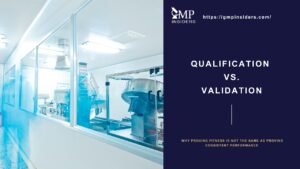An ISO Class 5 cleanroom represents one of the most controlled environments used in pharmaceutical and biotechnology manufacturing. It corresponds to the highest level of air cleanliness required for critical aseptic operations, where even minor airflow disturbances or unverified interventions can compromise sterility assurance.
Defined under ISO 14644-1, ISO 5 sets strict particle concentration limits and demands unidirectional airflow, high-efficiency filtration, and continuous environmental control.
In GMP facilities, ISO 5 conditions are typically aligned with EU GMP Grade A, the zone where product, components, and exposed sterile surfaces must remain protected throughout aseptic processing. These environments support activities such as aseptic filling, sterile filtration, critical manipulations, and the operation of isolators or RABS.
Understanding ISO Class 5 requirements is essential not only for designing compliant cleanrooms but also for maintaining a validated state, implementing effective monitoring programmes, and ensuring that the cleanroom continues to meet regulatory expectations over its lifecycle.
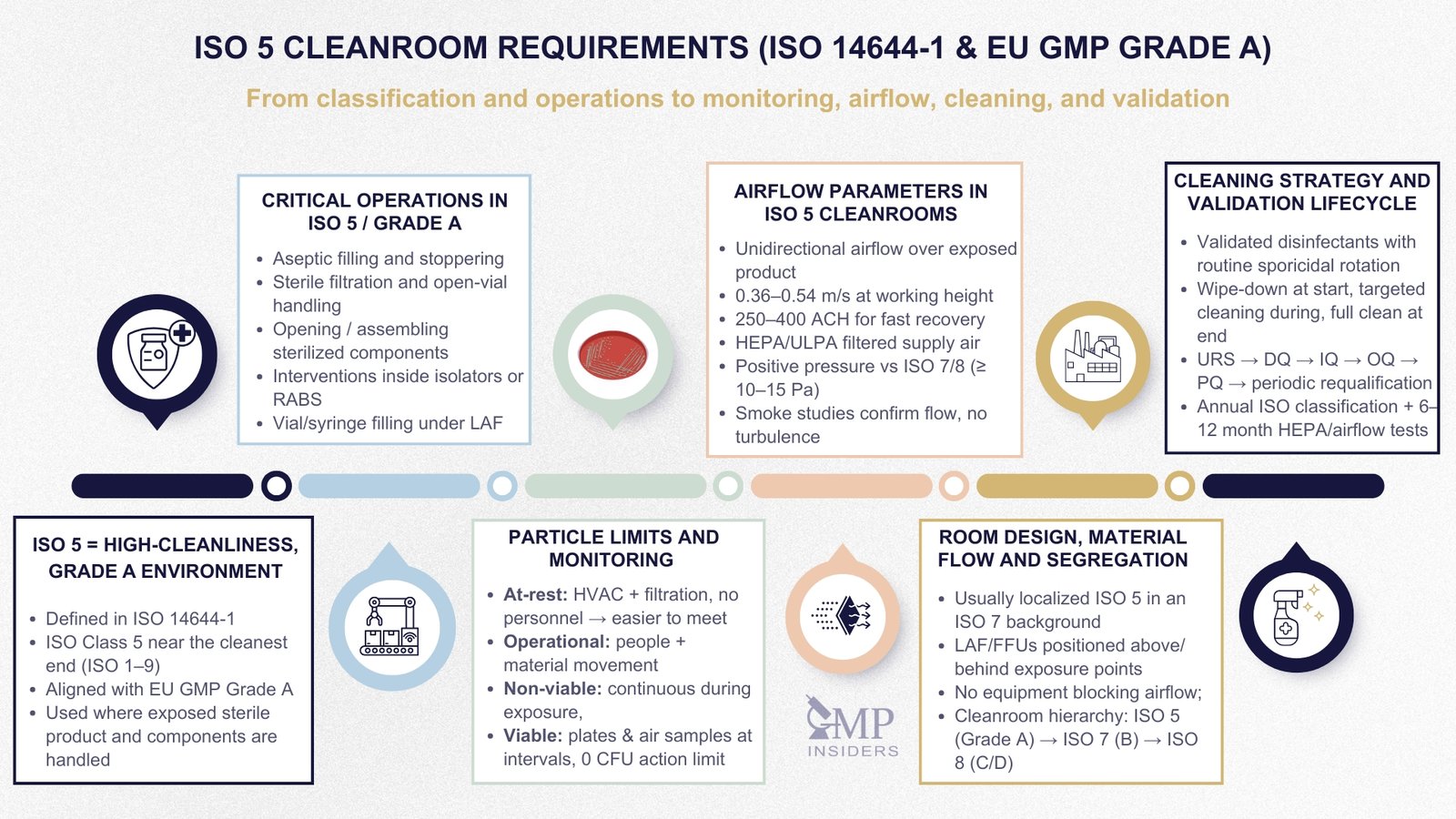
What Is an ISO 5 Cleanroom?
An ISO 5 cleanroom (or ISO Class 5 cleanroom) is a controlled environment defined by ISO 14644-1, with strict limits on airborne particles and specific requirements for airflow, filtration, and environmental control.
ISO 14644-1 classifies cleanrooms into ISO Class 1 to ISO Class 9 based on particulate concentration; ISO 5 sits at the high-cleanliness end of this spectrum and is commonly used for operations where sterility, precision, or contamination control is critical.
In pharmaceutical and biotechnology manufacturing, ISO 5 conditions align directly with EU GMP Grade A, which represents the cleanest environment required for aseptic processing. Grade A/ISO 5 is the zone in which exposed sterile products, sterilized components, or critical sterile interfaces are handled. This includes aseptic filling lines, sterile filtration steps, open-vial processing, and key interventions inside isolators and RABS.
Although ISO 5 is most closely associated with sterile manufacturing, it is also used in other high-precision sectors such as medical device assembly and ATMP/Cell & Gene Therapy production, where stringent airborne particulate control is essential. Understanding ISO 5 within the broader ISO 1–9 classification framework, and recognizing its connection to GMP Grade A, provides the foundation for proper design, qualification, and operational control of these environments.
SEE ALSO: Cleanroom Classification According to ISO 14644-1
Typical Operations Performed in ISO Class 5 Zones
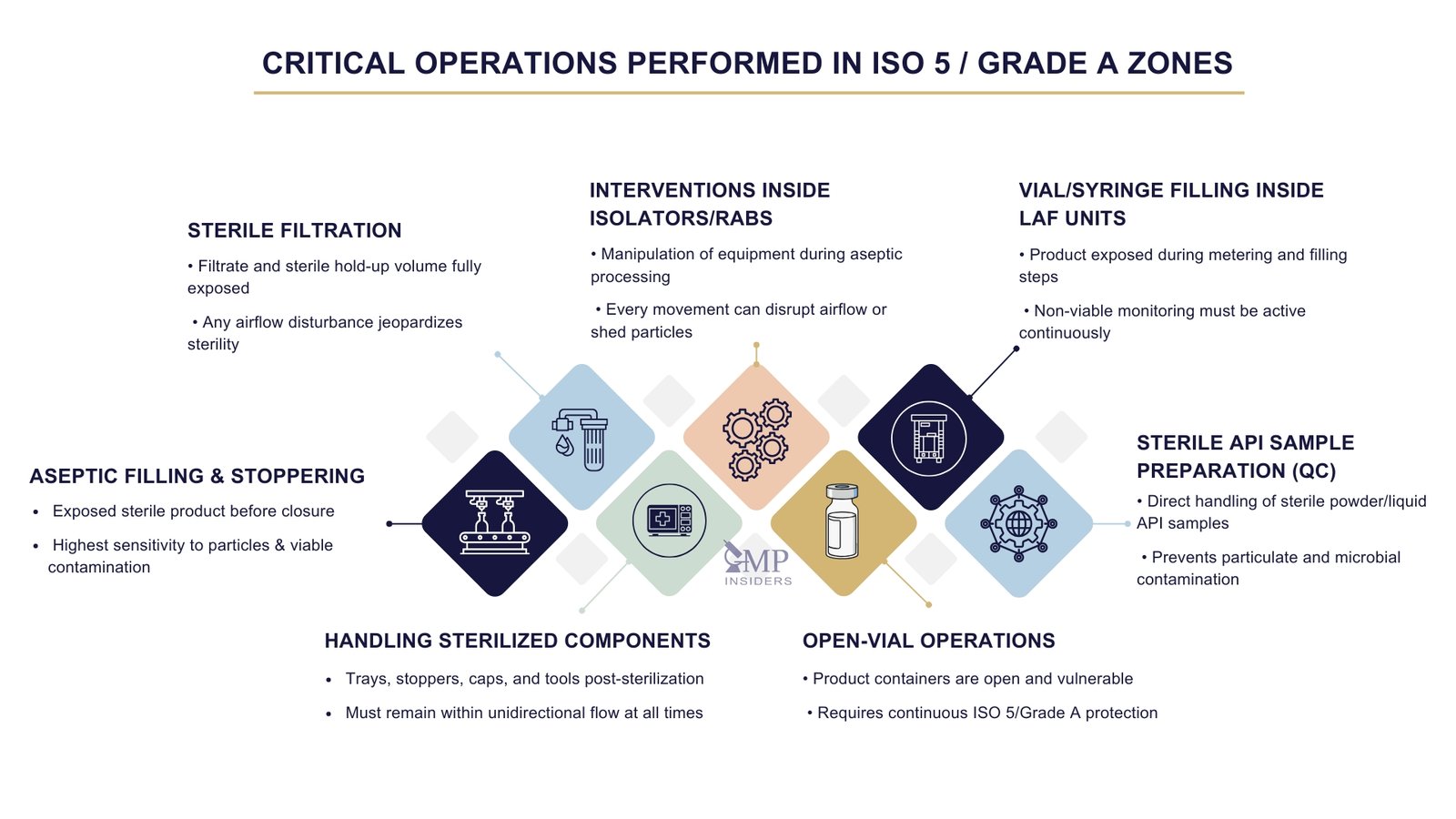
In GMP and pharmaceutical settings, ISO Class 5 (Grade A) areas are used for tasks that require sterility at all times. Common examples include:
- Aseptic filling and stoppering
- Sterile filtration and direct handling of sterile solutions
- Opening, transferring, or assembling sterilized components
- Critical interventions inside isolators or RABS
- Handling of exposed sterile product prior to closure
- Vial or syringe filling inside laminar airflow units
- Preparation of sterile API samples in QC
These operations all require stringent control of both viable and non-viable contamination because even minor disturbances can compromise sterility assurance.
ISO Class 5 Particle Count Limits
The cleanliness of a class ISO 5 cleanroom is defined by strict limits on the number of airborne, non-viable particles allowed per cubic meter of air. These limits originate from ISO 14644-1, which establishes internationally recognized thresholds for each ISO class based on particle size distribution.
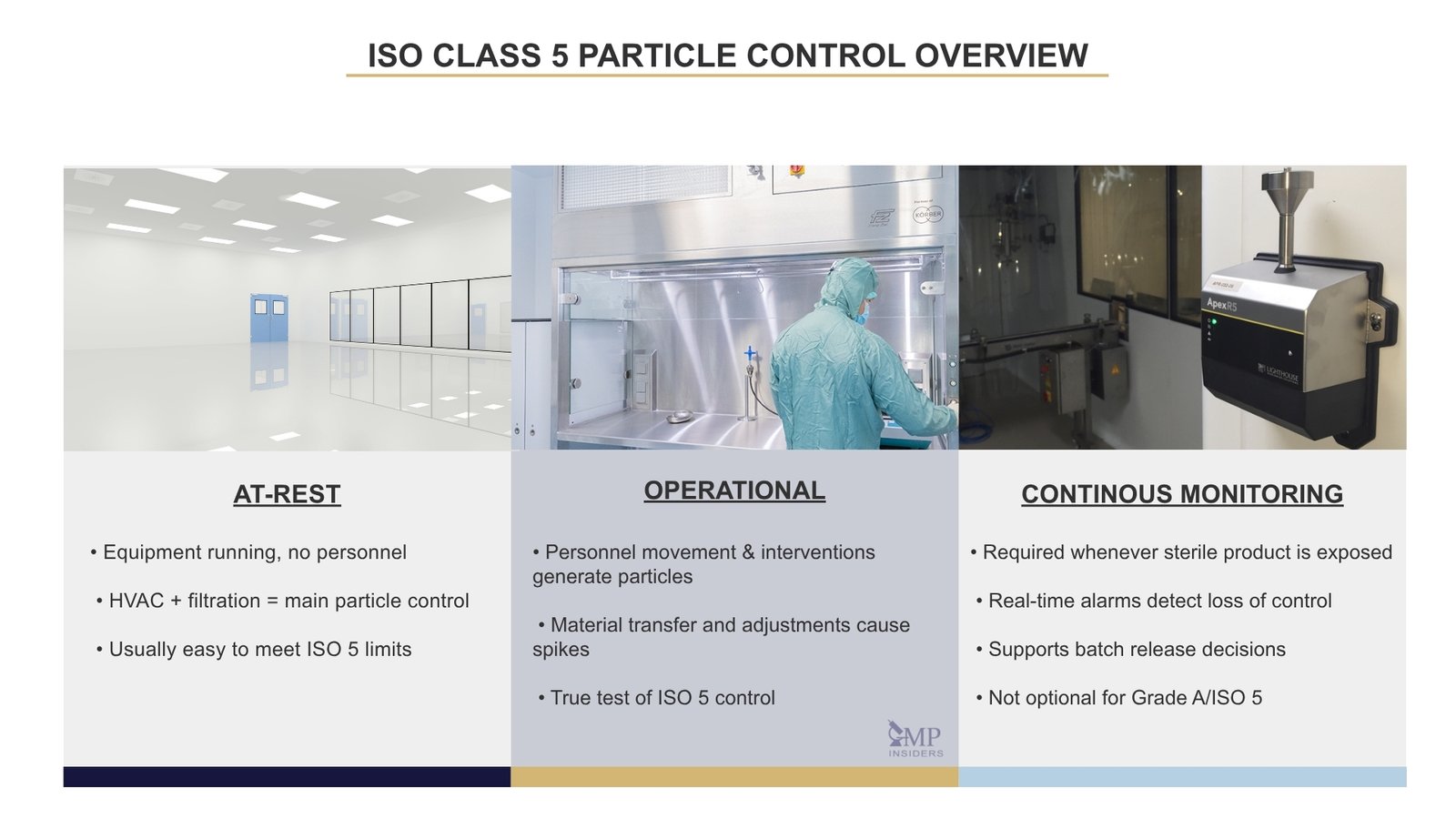
Because ISO 5 is used for the most contamination-sensitive operations, its particle allowance is several orders of magnitude tighter than ISO 7 or ISO 8 background areas.
Maintaining ISO 5 conditions requires a combination of high-efficiency filtration, unidirectional airflow, continuous air renewal, and strict control over personnel movement and interventions. Any disturbance, human, mechanical, or process-related, can immediately influence particle concentrations, which is why monitoring at this level is far more demanding.
Class ISO 5 Non-Viable Particle Limits According to ISO 14644-1
For an environment to qualify as ISO Class 5, the maximum allowable particle counts per cubic meter are:
| Particle Size | ISO 5 Limit (per m³) | What This Means in Practice |
|---|---|---|
| ≥ 0.5 µm | 3,520 particles/m³ | Even small disturbances can trigger spikes; requires stable unidirectional airflow |
| ≥ 1.0 µm | 832 particles/m³ | Personnel movement significantly influences results; gowning discipline critical |
| ≥ 5.0 µm | 29 particles/m³ | Near-zero tolerance for large particles; failures often indicate equipment/HEPA issues |
These values describe the upper boundary of acceptable particle concentrations. In practice, well-designed and properly functioning ISO 5 areas typically operate well below these limits due to high air-change rates and unidirectional airflow.
At-Rest vs Operational Classification
ISO 14644-1 allows cleanrooms to be classified in two primary operating states:
At-rest condition
- Equipment is installed and operating.
- No personnel are present.
- Airflow patterns and filtration systems are the primary drivers of particle control.
- Most facilities easily meet ISO 5 at-rest if the HVAC system is properly designed.
Operational condition
- Equipment is functioning, and personnel are performing everyday activities.
- Contamination arises from interventions, material transfer, line adjustments, and gowning behaviour.
- Maintaining ISO 5 under operational conditions is far more challenging and is the true indication of control.
Continuous vs Periodic Non-Viable Monitoring
Particle monitoring in class ISO 5 environments is more demanding than in lower ISO classes.
Continuous monitoring (expected for ISO 5 / Grade A)
- Required during all critical aseptic operations, such as filling, stoppering, and sterile filtration.
- Particle counters must be located close to the point of highest risk (e.g. filling needles, open vials, exposed product paths).
- Real-time data provides immediate detection of loss of control and supports batch release decisions.
- Data must be trended and reviewed as part of ongoing contamination control.
Periodic Monitoring (acceptable for background areas)
- Used in ISO 7 and ISO 8 rooms during set-up, routine operations, or recovery.
- Not sufficient for areas classified as Grade A / ISO 5.
Regulators expect that at any moment a sterile product is exposed, non-viable monitoring is active. This expectation aligns with EU GMP Annex 1 requirements for the continuous protection of Grade A zones.
Environmental Monitoring in Class ISO 5 Cleanrooms
Maintaining ISO 5 conditions requires more than meeting the particle limits defined in ISO 14644-1. These environments must also demonstrate continuous control through a structured environmental monitoring (EM) program.
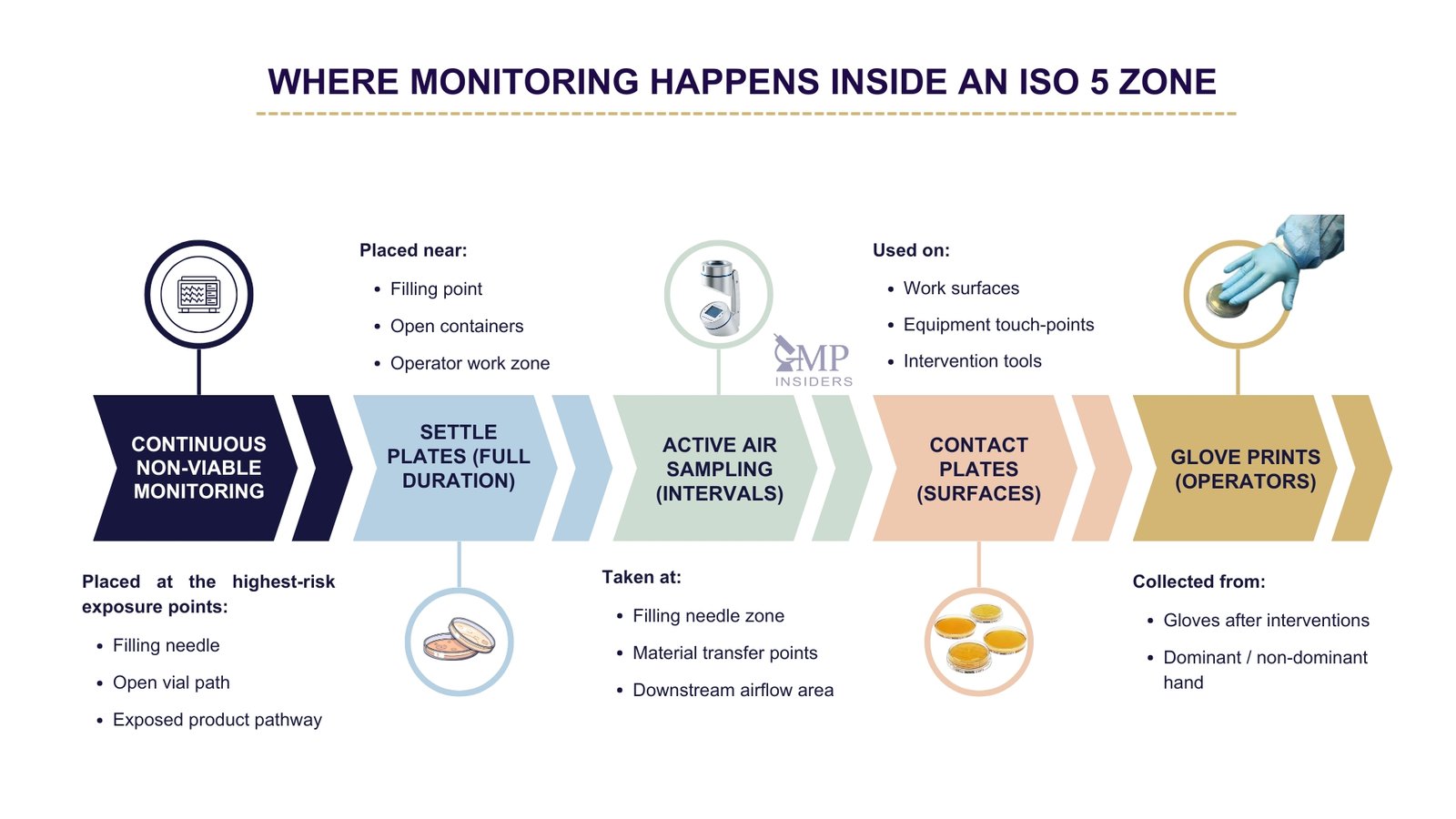
Class ISO 5 corresponds to EU GMP Grade A, where the most sensitive aseptic operations occur. For this reason, regulators expect a monitoring approach that covers both non-viable particles and viable microorganisms, each evaluated at a frequency and intensity appropriate to the process’s criticality.
Environmental monitoring in ISO 5, therefore, combines three elements:
- real-time non-viable particle monitoring
- scheduled viable monitoring, and
- interpretation of results within a contamination control strategy (CCS)
| Monitoring Type | Methods Used | Frequency | Purpose | Regulatory Expectation (Grade A / ISO 5) |
|---|---|---|---|---|
| Non-Viable Monitoring | Real-time particle counters near filling needles, open vials, exposed product paths | Continuous whenever sterile product or components are exposed | Detect loss of airflow control, HEPA issues, interventions, turbulence | Mandatory continuous monitoring; results support batch release |
| Viable Monitoring | Active air sampling, settle plates, contact plates, glove prints | Scheduled intervals during the aseptic operation | Detect microbial contamination not captured by particle counters | Action limit = 0 CFU; any growth requires immediate investigation |
| CCS Interpretation | Trending, alarm review, risk-based sampling | Ongoing | Identify patterns or contamination signals | Must be built into the site's Contamination Control Strategy |
Non-Viable Particle Monitoring in Class ISO 5 / Grade A
Non-viable monitoring provides immediate, continuous information about the performance of the airflow system, HEPA/ULPA filtration, and unidirectional flow. Because ISO 5/Grade A areas house aseptic filling, stoppering, and sterile filtration operations, they must remain under strict control at all times.
Continuous monitoring is the standard in these zones. Particle counters are positioned at the highest-risk locations, typically near open containers, filling needles, or product paths, so any loss of control is detected instantly. This real-time data serves as the primary indicator that ISO 5 conditions are preserved while operators work and equipment cycles.
Maintaining ISO 5 at-rest is usually achievable; maintaining ISO 5 during operation is what demonstrates accurate contamination control.
Viable Environmental Monitoring in ISO 5 Cleanrooms
While non-viable monitoring shows how air behaves, viable monitoring assesses whether microorganisms are present in the environment. EU GMP Annex 1 sets clear expectations for viable monitoring in Grade A/ISO 5 zones, emphasizing that even minimal microbial recovery is abnormal.
Viable monitoring in ISO 5 cleanrooms typically includes a combination of active air sampling, settle plates, contact plates, and glove prints. These methods do not run continuously like particle counters; instead, they are performed at defined intervals designed to reflect the risk and duration of the aseptic operation. Together, they provide a microbiological picture of the zone that complements the real-time physical monitoring.
SEE ALSO: Types of Sampling Methods In Environmental Monitoring
Frequency Expectations for ISO 5 Monitoring
Because ISO 5 is the highest-risk environment, the frequency of monitoring is differentiated clearly between non-viable and viable methods. The goal is to capture both the system’s immediate performance and any microbiological events that may occur during the shift.
- Non-viable monitoring: Must be continuous during any period when sterile product or exposed sterile components are handled. Results directly support batch release and are subject to alarm thresholds.
- Viable monitoring: Performed at defined intervals, ensuring representative coverage of the entire operation, from line setup to completion. Settle plates remain exposed for the duration of the activity, while active air and contact plates are taken at points identified through risk assessment.
The combination of continuous and interval-based monitoring ensures coverage of both transient disturbances and potential microbial contamination.
Alert and Action Limits for Viable Contamination
Annex 1 specifies that Grade A (class ISO 5) viable contamination limits are extremely low, reflecting the expectation of near-sterile conditions.
Typical limits are:
- Grade A action limit: 0 CFU in air, surface, and glove samples
- Grade A alert level: facility-specific but often 0 CFU as well
Because any recovery in Grade A areas is considered abnormal, even a single CFU triggers:
- Immediate investigation
- Assessment of potential batch impact
- Review of personnel interventions
- Evaluation of airflow disturbances and equipment performance
Some facilities define internal alert levels (e.g., investigation thresholds) but the regulatory action level for Grade A remains zero growth.
SEE ALSO: GMP Cleanroom Classifications: Grade A, B, C, and D
Airflow Requirements and Control Parameters in ISO 5 Cleanrooms
Airflow design is one of the strongest determinants of whether an ISO Class 5 cleanroom maintains stable, compliant performance. ISO 5 / Grade A zones rely on unidirectional airflow, high air-change rates, and HEPA/ULPA filtration to continuously sweep away contamination generated by personnel, equipment, or interventions. These parameters must work together to create a uniform, highly predictable, clean environment.

Unidirectional Airflow in Class ISO 5
ISO Class 5 environments use unidirectional (laminar) airflow, meaning air moves in a single, uniform direction at a controlled speed. This constant downward or horizontal flow removes particles as soon as they are generated.
Why Unidirectional Flow is Critical
- Maintains a consistent direction of clean air over the exposed product.
- Reduces turbulence and particle recirculation.
- Protects critical processing zones, especially during operator interventions.
- Keeps contamination from migrating into open containers or sterile pathways.
In Grade A/ISO 5 conditions, unidirectional airflow is the primary method of maintaining aseptic integrity.
Air Velocity Requirements
To create a stable, unidirectional flow, ISO 5 areas must maintain a defined air velocity range.
Typical velocity for class ISO 5/Grade A zones:
- 0.36–0.54 m/s at the working height (industry-accepted range)
- Verified through airflow velocity tests and airflow visualization studies (smoke studies)
Air velocity must be:
- Uniform across the working plane
- Free from obstructions that cause turbulence
- Verified during qualification and periodically re-tested
Air Changes per Hour (ACH)
ISO Class 5 areas typically achieve very high air-change rates, often exceeding 250–400 air changes per hour, depending on design and room layout.
High ACH ensures:
- Fast removal of particulates
- Rapid recovery after disturbances
- Lower particle load entering Grade A zones from surrounding areas
Although ISO standards do not prescribe exact ACH numbers, these values are accepted industry benchmarks for maintaining ISO 5 uniformity.
HEPA and ULPA Filtration
Air entering a class ISO 5 cleanroom must pass through:
- HEPA filters (99.97% efficiency at 0.3 µm) or
- ULPA filters (≥ 99.9995% efficiency at 0.12 µm)
Filtration supports ISO 5 in several ways:
- Removes particulates before air reaches the critical zone
- Maintains consistent purity even during long production runs
- Prevents contamination ingress from upstream zones
HEPA filter integrity must be verified:
- At initial qualification (IQ/OQ)
- At scheduled intervals
- After maintenance, damage, or system modifications
This testing is usually performed using PAO (polyalphaolefin) challenge, DOP, or an equivalent aerosol method.
Differential Pressure and Room Cascade
Even though ISO 5 zones are often created locally using LAF units, isolators, or RABS, pressure control remains essential to prevent contamination from entering the critical area.
Typical pressure principles:
- Grade A/ISO 5 should be under positive pressure relative to Grade B/ISO 7 surroundings (unless handling hazardous material).
- Differential pressure is usually ≥ 10–15 Pa between cleanroom grades.
- Pressure must be monitored continuously, with alarms for deviations.
Maintaining these pressure cascades supports directional airflow from cleaner to less-clean areas.
How Airflow Parameters Work Together
Air velocity, air-change rate, filtration, and pressure differentials are interconnected. If one parameter drifts, the entire ISO 5 environment can fall out of control.
| Parameter | Typical Requirement | Purpose in ISO 5 / Grade A |
|---|---|---|
| Unidirectional Airflow | Uniform, single-direction flow | Prevents turbulence; protects exposed sterile pathways |
| Air Velocity | 0.36–0.54 m/s | Maintains stable laminar flow and particle sweep-out |
| Air Changes per Hour | 250–400 ACH | Fast recovery; low baseline particle load |
| HEPA/ULPA Filtration | 99.97–99.9995% efficiency | Delivers clean air; prevents contamination ingress |
| Differential Pressure | ≥ 10–15 Pa | Maintains directional flow from clean → less clean |
| Smoke Studies | Required annually | Confirms uniformity, no turbulence or obstruction |
Example interactions:
- Low velocity → Loss of unidirectional flow → Particle accumulation in critical zones
- HEPA leak → Contaminated air entering the zone → Non-viable spike
- Incorrect pressure cascade → Dirty air pulled into Grade A area
- Obstructions → Turbulence → Disrupted, non-uniform airflow
This is why airflow visualization (smoke studies) is a mandatory element of Annex 1 compliance.
Class ISO 5 Layout and Room Design
Designing an ISO 5 cleanroom requires ensuring that airflow, equipment layout, and personnel movement all support stable particle control. Even when ISO 5 is achieved locally through LAF units, isolators, or RABS, the overall room layout must prevent turbulence, unnecessary interventions, and cross-contamination.
Local vs Full-Room ISO 5 Configurations
ISO Class 5 conditions can be created locally or across an entire room. In GMP manufacturing, localized ISO 5 protection inside an ISO 7 background is the most common approach.
| Type | Where Used | Advantages | Challenges |
|---|---|---|---|
| Localized ISO 5 (most common) | Aseptic filling, filtration, RABS, isolators | Easier to validate; less HVAC burden; focused protection | Must be integrated with ISO 7; airflow must remain unobstructed |
| Full-Room ISO 5 | ATMP, microelectronics, optics | Uniform cleanliness; large-area protection | High cost; difficult to maintain & validate |
Localized ISO 5 environments include:
- Laminar airflow (LAF) workstations
- Isolators
- RABS (open or closed)
- Vertical or horizontal flow units
SEE ALSO: Laminar Flow Cabinets in GMP Facilities: Types and Application
Full-room ISO 5 cleanrooms are used when:
- Large open processing areas require uniform particle control
- High-precision industries (optics, microelectronics) need full-room protection
Most pharmaceutical facilities rely on localized ISO 5 zones, because they are easier to maintain and validate.
Placement of LAF Units and FFUs in ISO 5 Cleanrooms
A stable ISO 5 zone depends heavily on the correct positioning of LAF hoods and Fan Filter Units (FFUs). These must deliver clean, uniform airflow directly to the critical working area.
Key placement principles:
- Air supply should be positioned directly above or behind sterile exposure points
- No equipment edges should obstruct airflow
- Operators must avoid leaning into the airflow path
- Air returns should be placed to support downward or horizontal flow
- Equipment arrangement must preserve laminar flow, not fight it
| Design Principle | Explanation |
|---|---|
| Air supply above/behind exposure points | Ensures clean air hits the product first |
| No equipment blocking airflow | Prevents turbulence or recirculation |
| Operators stay out of airflow path | Avoids shedding contamination into ISO 5 zone |
| Air returns positioned correctly | Supports laminar flow, avoids dead zones |
| Equipment aligned with airflow | Maintains laminar integrity |
Correct placement provides consistent ISO 5 protection during normal operations and interventions.
Material and Personnel Flow
Material and personnel movement are among the strongest influencers of airflow stability. Poorly designed flows cause turbulence, particle spikes, and operator-dependent variation.
Material flow design should include:
- Transfer through interlocked pass boxes or hatches
- Pre-sterilized items only
- Clear separation of incoming and outgoing materials
- Defined staging areas to avoid clutter in ISO 5 zones
Personnel flow should:
- Follow a controlled sequence from ISO 8 → ISO 7 → ISO 5
- Minimize reaching or crossing above exposed product
- Avoid fast or unnecessary movements that disrupt airflow
- Follow ergonomic workstation design to reduce interventions
A well-built flow pattern significantly reduces contamination risks.
Role of Pass Boxes in ISO Class 5 Protection
Pass boxes allow materials to move between cleanroom grades without opening doors or disturbing pressure cascades.
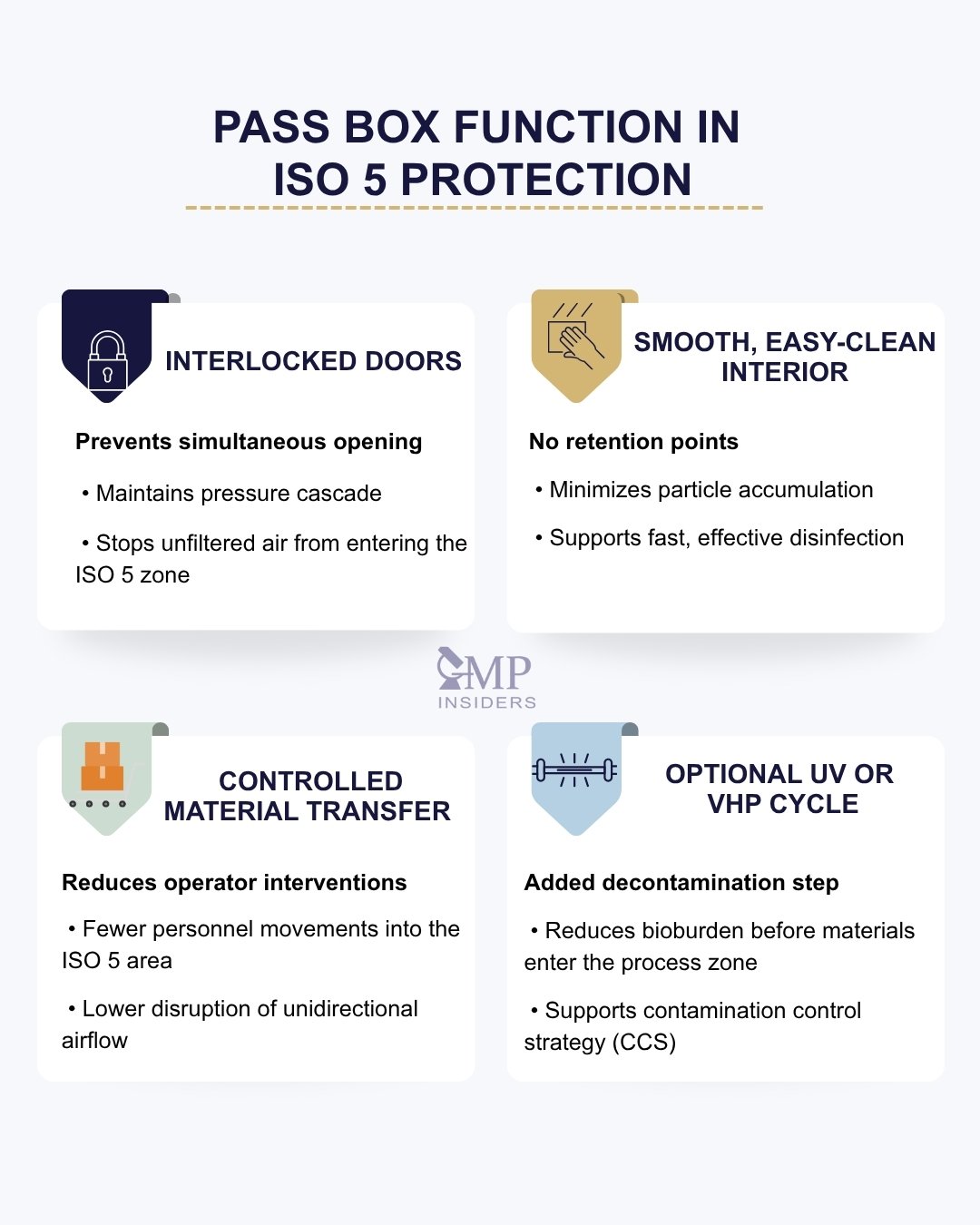
Effective pass box design includes:
- Door interlocks to prevent simultaneous opening
- Smooth, easy-clean interiors with no retention points
- Clear operating procedures to avoid unnecessary transfers
- Optional UV or VHP-based decontamination, depending on process needs
They support ISO 5 protection by lowering intervention frequency.
Segregation Between ISO 5 and Surrounding Areas
ISO 5 environments must be integrated into a cleanroom suite with proper grade separation to maintain stability.
Typical GMP hierarchy:
- ISO 5 (Grade A): Critical zone
- ISO 7 (Grade B): Background area for aseptic processing
- ISO 8 (Grade C/D): Preparation and support zones
Design considerations:
- Maintain correct pressure cascade (ISO 5 positive to ISO 7)
- Avoid turbulent mixing near doorways
- Use airlocks where personnel transitions are required
- Implement controlled door interlocks
Surrounding room quality strongly influences ISO 5 robustness.
Cleaning and Disinfection Requirements for ISO 5 Cleanrooms
Cleaning and disinfection in an ISO 5 cleanroom must consistently support the extremely low contamination levels required for aseptic operations. Because ISO 5 corresponds to EU GMP Grade A, any lapse in cleaning can immediately influence non-viable and viable counts, airflow behavior, and sterility assurance.
The cleaning program must therefore be structured, justified, and supported by validated disinfectants and controlled execution.
Cleaning and Disinfection Principles in ISO 5 Areas
ISO 5 zones are highly sensitive to contamination, as even low levels of particles or microorganisms can compromise sterile products. The cleaning approach must prioritize removal of residues, control of bioburden, and prevention of microbial adaptation.
Core principles include:
- Maintain particle-free, residue-free surfaces
- Use disinfectants effective against a wide spectrum of microorganisms
- Integrate sporicidal agents at routine intervals
- Apply a validated rotation strategy to prevent microbial resistance
- Ensure cleaning does not disrupt airflow or introduce particulates
- Document every activity in real time (ALCOA++ principles)
Selection and Validation of Disinfectants
Disinfectants used in class ISO 5 areas must be supported by validation studies demonstrating their effectiveness in cleanroom conditions.
Key validation parameters:
- Spectrum of activity (bacteria, fungi, spores)
- Contact time requirements
- Cleanroom material compatibility
- Residue potential and removability
- Microbial log reduction performance
- Frequency of use (daily, weekly, periodic sporicidal)
| Parameter | Why It Matters in ISO 5 |
|---|---|
| Spectrum of activity | Must cover bacteria, fungi, spores |
| Contact time | Ensures full log reduction |
| Compatibility | Must not damage LAF/RABS surfaces |
| Residue profile | Prevents particle buildup |
| Frequency of use | Supports rotation strategy |
| Log reduction performance | Demonstrates validated efficacy |
Typical agents for ISO 5 zones:
- 70% isopropanol or ethanol (routine use)
- Hydrogen peroxide blends
- Quaternary ammonium compounds
- Chlorine-based disinfectants (for periodic use)
- Sporicidal agents (hydrogen peroxide/peracetic acid mixtures)
Selection must consider the facility’s contamination profile and environmental monitoring trends.
Cleaning Frequency and Schedules in ISO 5 Cleanrooms
Cleaning in ISO 5 zones is performed more frequently than in lower-grade areas due to higher risk and lower tolerance for contamination.

Typical ISO Class 5 cleaning schedule includes:
- Start of operation: Full wipe-down of all critical surfaces
- During operation: Targeted disinfection after each intervention
- End of operation: Complete cleaning of equipment, surfaces, and reachable areas
- Daily or shift-based: Disinfection of interior surfaces of LAF units, isolators, or RABS
- Weekly: Application of sporicidal agents
- Periodic deep-cleaning: Full cleaning, including less accessible areas
Each task must be clearly defined in the SOP, including the method, disinfectant type, contact time, and responsible personnel.
Handling of Critical Surfaces
Certain surfaces in ISO 5 zones require special attention. These surfaces are closest to the exposed product or sterile components.
| Surface | Reason It’s Critical | Cleaning Requirement |
|---|---|---|
| Work surfaces under LAF | Direct exposure zone | Clean at start/end and after interventions |
| Isolator/RABS chamber interior | Primary aseptic boundary | Daily + after interventions |
| Filling needles & product pathways | Direct contact with open product | High-frequency disinfecting |
| Equipment touch-points | Operator contact | Frequent contact plate checks |
| Tools used in interventions | High contamination risk | Sterile and disinfected before use |
Critical surfaces include:
- Work surfaces under LAF
- Inside isolators or RABS chambers
- Equipment parts in direct exposure zones
- Filling needles, conveyance paths, stopper bowls (where accessible)
- Tools and utensils used during aseptic manipulations
These areas must be cleaned and disinfected with techniques that avoid generating aerosols, particulates, or turbulence.
Cleaning Tools and Materials Suitable for ISO 5
Only approved, low-shedding materials should be allowed inside ISO 5 areas to avoid particle introduction.
Acceptable materials:
- Sterile, low-lint wipes
- Sterile pre-saturated disinfectant wipes
- Smooth, cleanroom-compatible mops
- Sterile spray bottles with tamper-evident seals
- Cleanroom-grade buckets and accessories
Not acceptable:
- Non-sterile wipes
- Cotton cloths or linting fabrics
- Household-grade cleaning tools
- Containers without proper sterile integrity
All materials used inside ISO 5 must be introduced through controlled transfer procedures.
Qualification and Validation Requirements for ISO 5 Cleanrooms
ISO 5 cleanrooms must demonstrate that they consistently operate within the limits defined by ISO 14644-1 and EU GMP Annex 1. Achieving and maintaining ISO 5 performance requires a structured qualification and validation program covering design, installation, operational performance, and ongoing verification.
Unlike lower cleanroom grades, ISO 5 zones undergo more intensive testing because they support activities in which sterile products are exposed and contamination tolerance is essentially zero. Qualification and validation activities confirm that the cleanroom is designed correctly, performs as intended, and remains validated throughout its lifecycle.
| Stage | Purpose | Key Outputs for ISO 5 |
|---|---|---|
| URS | Define functional, quality, and regulatory requirements | ISO 5 classification; unidirectional airflow; continuous non-viable monitoring; pressure cascade; cleanroom finishes |
| DQ | Confirm design meets URS and GMP/ISO standards | Layout (ISO 5→7→8); HVAC specs; HEPA/ULPA type; airflow patterns; equipment placement; EM system integration |
| IQ | Verify installation against design & vendor specs | HEPA installation check; sensor calibration; pass box interlocks; as-built measurements; drawings & configuration records |
| OQ | Demonstrate performance at-rest | Air velocity/uniformity; HEPA integrity (PAO/DOP); smoke studies; pressure differentials; recovery time; EMS alarms |
| PQ | Demonstrate performance under normal operation | Particle limits met under operation; viable/NV monitoring; process simulation; operator interventions; airflow robustness |
Qualification Lifecycle for ISO 5 Cleanrooms
Cleanroom qualification follows the standard GMP validation lifecycle:
1. User Requirement Specification (URS)
Defines the requirements for an ISO 5 cleanroom.
Key elements include:
- Required ISO class (ISO 5)
- Intended use (aseptic filling, sterile filtration, isolator operation, etc.)
- Expected occupancy (at-rest vs operational)
- Airflow type (unidirectional)
- EM requirements (continuous non-viable monitoring)
- Pressure cascades and segregation needs
- Cleanroom finishes and material compatibility
URS sets the foundation for all design and qualification activities.
2. Design Qualification (DQ)
Ensures the proposed cleanroom design meets the URS and applicable standards.
DQ typically covers:
- ISO classification layout (ISO 5 → ISO 7 → ISO 8 flow)
- HVAC design specifications
- HEPA/ULPA filtration type and efficiency
- Pressure cascades and airflow patterns
- Modular structure, materials, and finishes
- Equipment placement relative to airflow
- Environmental monitoring system integration
The DQ demonstrates that the design can realistically achieve ISO 5 performance.
SEE ALSO: Design Review and Design Qualification in the Pharmaceutical Industry
3. Installation Qualification (IQ)
Confirms the cleanroom is installed in accordance with the approved design and vendor specifications.
IQ documentation includes:
- Verification of HEPA filter installation
- As-built room measurements and finishes
- Identification and calibration of sensors (pressure, temperature, humidity)
- Verification of air supply and exhaust systems
- Pass box interlocks, lighting, and fixtures
- Labeling, drawings, and configuration records
IQ ensures the cleanroom is physically built as intended.
4. Operational Qualification (OQ)
Evaluates the performance of the cleanroom systems under defined operating conditions, typically at-rest.
OQ tests include:
- Airflow velocity and uniformity
- HEPA filter integrity testing (PAO/DOP)
- Airflow visualization (smoke studies)
- Pressure differential verification
- Temperature and humidity mapping
- Recovery time testing
- Alarm and EMS functionality checks
Passing OQ confirms that the cleanroom can achieve ISO 5 conditions before personnel enter.
5. Performance Qualification (PQ)
Verifies the cleanroom performs as intended during normal operation, including personnel activity and equipment use.
PQ confirms:
- ISO 5 particle limits under operational conditions
- Non-viable monitoring system performance
- Viable monitoring at routine sampling points
- Representative process simulations (if applicable)
- Interventions and routine movements do not break ISO 5 control
For aseptic processes, PQ may be linked to aseptic process simulation (media fill), which is critical for demonstrating operational sterility assurance.
SEE ALSO: IQ, OQ, PQ: Importance in GMP
Key Tests Required for ISO 5 Classification
To formally classify and maintain ISO 5 status, several tests must be performed initially and periodically.
Mandatory ISO 14644-1 classification tests:
- Non-viable particle count testing
- Airflow velocity and direction
- HEPA/ULPA filter integrity testing
- Air pressure differentials
- Airflow visualization studies
- Recovery time measurements
GMP-required verification also includes:
- Viable environmental monitoring
- Cleaning and disinfection effectiveness checks
- Personnel qualification (gowning, aseptic behavior)
- EM system validation (alarms, trending, audit trail)
These tests together confirm both ISO compliance and GMP suitability.
Ongoing Requalification and Periodic Review
ISO 5 areas require more frequent requalification than lower-grade cleanrooms due to their criticality.
Typical requalification frequency:
- HEPA integrity tests: every 6–12 months
- Airflow velocity tests: every 6–12 months
- Airflow visualization (smoke study): every 12 months
- Full ISO classification testing: annually
- Pressure differentials: continuously monitored
- Non-viable particle monitoring: continuous during operation
GMP Annex 1 requires that requalification frequency be based on risk and historical EM performance.
FAQ
Can an ISO 5 Cleanroom Be Certified Without Integrating a Full Environmental Monitoring System?
No. ISO 14644 classification alone is not sufficient for GMP use; ISO 5 areas must be supported by a validated environmental monitoring (EM) system. Non-viable monitoring must function continuously during aseptic operations, and viable monitoring must follow a structured sampling plan compliant with Annex 1.
An ISO 5 area can meet the particle limits at the time of testing, but still be non-compliant if routine EM is inadequate. Regulators focus on the system’s ability to detect loss of control, not just on successful initial classification. Therefore, EM is a core element of ISO 5 certification in pharmaceutical settings.
Do ISO 5 Cleanrooms Require Dedicated HVAC Systems?
Not always as a separate system, but they do require dedicated control loops and filtration stages. Most ISO 5 zones are supplied through specialized LAF units, FFUs, or isolator chambers that receive HEPA-filtered air from higher-grade HVAC branches.
Even when ISO 5 is part of a larger suite, airflow parameters must be monitored and controlled individually. Shared HVAC should never compromise pressure, airflow direction, or cleanliness class. Risk assessment determines whether isolation or independent control is needed.
How Long Should the Recovery Time Be In an ISO 5 Cleanroom?
Recovery time is the period required for particle levels to return to ISO 5 limits after a disturbance. Typical expectations range from a few seconds in isolators to under 5 minutes in open ISO 5 zones, although this depends on airflow velocity, ACH, and equipment layout.
Recovery should be verified during qualification using controlled particle release. Excessively long recovery times indicate airflow inefficiency or turbulence. Regulators often review recovery data to assess the robustness of airflow design.
Is ISO 5 Achievable Without Unidirectional Airflow?
For GMP applications, no. ISO 5 classification can, in theory, be achieved with turbulent airflow, but this does not meet the requirements for Grade A aseptic operations. Unidirectional airflow ensures that particles are continuously removed from the critical zone, preventing recirculation or settling. It also allows predictable airflow behavior during interventions. Without unidirectional flow, sterile operations would be at unacceptable risk.
Can ISO 5 Zones Share Equipment With ISO 7 or ISO 8 Rooms?
Generally, no, unless the equipment is fully enclosed, cleaned, and transferred under controlled conditions. Shared equipment increases the risk of cross-contamination and may disturb pressure cascades. If equipment must move between grades, validated cleaning, sanitization, and transfer procedures must be followed.
In aseptic filling lines, equipment remains permanently within the ISO 5/ISO 7 environment. Most facilities avoid shared equipment for critical operations.
How Often Must Operators be Qualified to Work in ISO 5 areas?
Operator qualification includes gowning, aseptic technique, and behavioral assessments. Most GMP facilities require requalification every 6–12 months, depending on performance and EM trends.
Operators failing glove prints or aseptic technique simulations must undergo retraining. Annex 1 emphasizes ongoing capability rather than one-time qualification. Operator presence is the most significant variable in ISO 5 performance, so training is continuous.
Are All ISO 5 Environments Considered Sterile?
No. ISO 5 environments are “clean” and meet strict particulate limits, but they are not inherently sterile. Sterility depends on validated disinfection, equipment sterilization, and aseptic technique. Even with zero CFU limits, microorganisms may still be introduced through operators or materials. ISO 5 provides the airflow and environmental control needed to support sterility assurance, not replace it. Actual sterility is maintained through aseptic processes.
Final Thoughts
ISO Class 5 cleanrooms form the core of aseptic processing. Their performance determines whether sterile products remain protected during the most critical stages of manufacturing, and their control depends on more than just meeting particle limits at the time of classification.
Airflow behavior, environmental monitoring, cleaning practices, operator technique, and qualification data all have to work together day after day to maintain a space where contamination risk stays acceptably low.
When designed well, operated consistently, and supported by reliable monitoring and robust training, ISO Class 5 environments remain stable even under demanding production conditions. When any part of the system breaks down, airflow, equipment setup, disinfectant strategy, or personnel behavior, ISO 5 control can deteriorate quickly, often without obvious visual signs. This is why regulators place so much emphasis on continuous data, clear procedures, and regular verification.
For manufacturers, the real value lies in understanding ISO 5 not just as a classification, but as an operational commitment. Once this perspective becomes part of the contamination control strategy, ISO 5 ceases to be a static requirement and becomes a reliable framework for supporting safe, compliant, and reproducible aseptic operations.

